(MENAFN- ProactiveInvestors)

Early last week I was in Melbourne Austrailia attending a conference for chief executives from all over the world. While there I spoke with many of my peers about the airline industry which is currently in a three-year bull run as measured by the S&P 500 Airlines Index.
I was surprised to learn that several people incorrectly assumed that the airline industry is included in the consumer discretionary sector of the S&P 500 Index. It does seems as if it belongs there along with travel hospitality and leisure. But the industry actually qualifies as an industrial.
Regardless of which sector airlines belong in the fleet has flown past both industrials and consumer discretionaries for the five-year period.
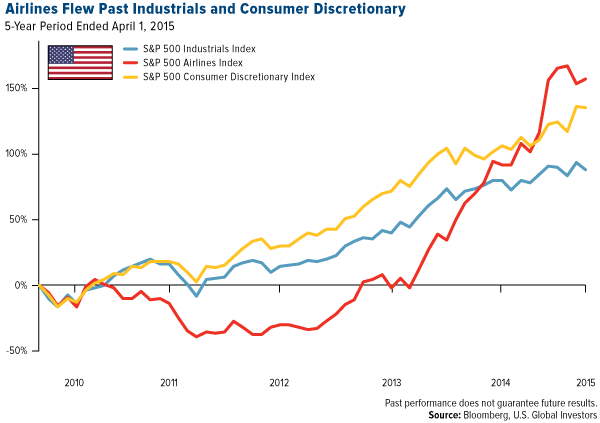
click to enlarge
Not only that but airlines was the best-performing industry in industrials for the one-year three-year and five-year periods.
Airlines: The Best-Performing Industry in the Industrials Sector
As of April 1 2015 | Percent Change |
| 1-Year | 3-Year | 5-Year |
| Airlines +45% | Airlines +288% | Airlines +142% |
| Professional Services +21% | Building Products +109% | Road & Rail +134% |
| Commercial Services & Suppliers +19% | Aerospace & Defense +75% | Aerospace & Defense 93% |
A misconception held among some investors is that airline stocks are outperforming right now only because fuel costs are down. Fuel after all accounted for about 30 percent of carriers’ operating costs in 2014. The implication some believe is that when oil prices begin to recover airlines will be first to feel the pinch.
This isn’t necessarily the case. The industry is in a much more rational business environment than it was a decade ago. Over the last five years fundamental changes have taken place including consolidation new sources of revenue better fuel efficiency and additional seats that have helped airlines excel even when oil is $100 per barrel or more.
In fact airline stocks for the four industry leaders—United Airlines American Airlines and —began their recent ascent even before oil prices began to plummet 50 to 60 percent starting last summer.
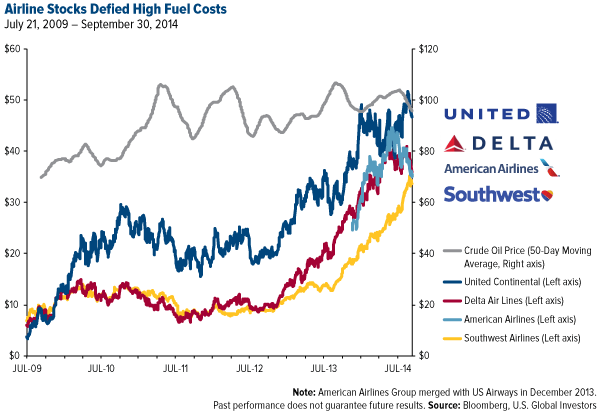
click to enlarge
And because most airlines hedge their fuel they’re still locked into $100-per-barrel oil prices and therefore haven’t yet felt the full benefits of lower fuel costs. American is one of the few that doesn’t hedge.
Airline research analyst Helane Becker of financial services firm Cowen Group writes:
American participates in 100 percent of the decline in jet fuel prices. The current per gallon price is $1.78 and American uses 4.4 billion gallons of jet fuel annually so every $1 change in oil [saves the company] approximately $105 million per month.
Contributing to American’s diminishing operating costs is its purchase of dozens of new aircraft—99 delivered last year 112 expected this year—that will replace older less-fuel efficient jets. This should help the company save millions not only in jet fuel but also maintenance fees for many years to come.
It should also be noted that new baggage-tracking technology has led to a dramatic decrease in lost and mishandled luggage helping airlines all over the globe save billions and keeping passengers happy as well. Even as the number of worldwide passengers has steadily increased year-over-year—exceeding a record three billion in 2013—there’s been a drop of 61 percent in missing bags since the peak in 2007. As a result carriers save a collective $18 billion a year.
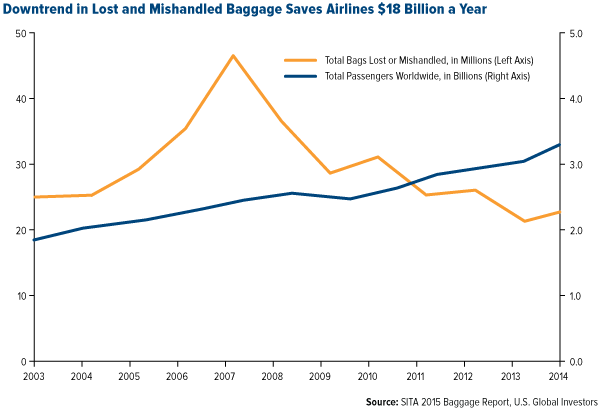
click to enlarge
Free Cash Flow
Often it’s not enough to look just at a company’s revenue for any given timeframe to determine its strength. A more precise metric is free cash flow which tells you how much cash the company has in the bank after taxes and all operating expenses have been paid. In other words it’s what the company is “free” to spend.
The higher a company’s free cash flow yield the better. When the yield is higher the company is more likely to plow that extra cash back into its growth or declare a dividend. American for instance began paying a dividend last summer; Alaska Airlines the summer before last.
Last year Delta announced a stock buyback plan worth $2 billion and a dividend increase of 50 percent. At this May’s Merrill Lynch Industrials Conference the company is expected to make a similar announcement—another buyback authorization and a possible dividend boost of 25 percent.
As you can see below U.S. airlines’ free cash flow is expected to reach a record high this year and each sequent year. Domestic carriers have never had this much cash potential on their hands—cash that can be used to grow and improve their businesses as well as reward shareholders.
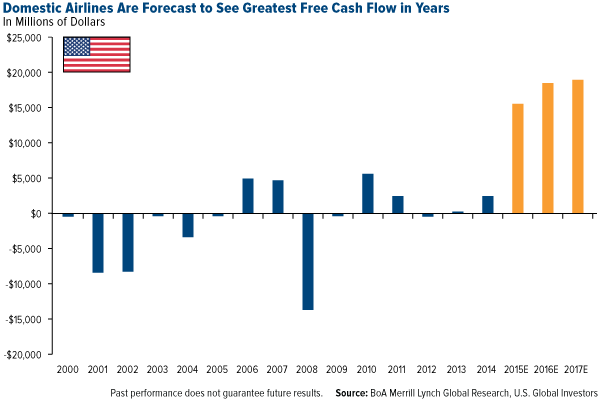
click to enlarge
If we look at individual companies’ free cash flow three of them—Delta Southwest and United Airlines—are expected to have yields above an impressive 10 percent in 2015.
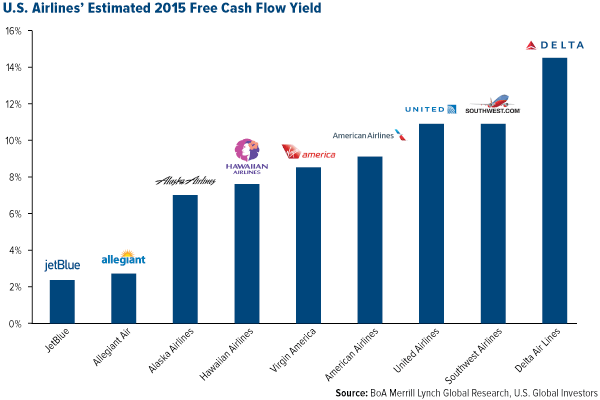
click to enlarge
An airline industry report by J.P. Morgan stated today:
We believe in the persistence of cash flows and the presence of a good structural model. The sector has begun to show us their success instead of repeating “trust me”… [T]he cash is real the margins are real the buybacks are real.
In light of this success some analysts are concerned that airlines flush with cash for the first time in recent memory will increase capacity too quickly and outpace demand.
Two main arguments can be made here. For one the industry is highly correlated to a nation’s GDP and carriers have historically avoided growing faster than the economy by too wide of a margin. The second argument has to do with what experts believe is an imminent pilot shortage in the U.S.
Pilot Shortage Ahead
The Federal Aviation Administration (FAA) mandates that all pilots must retire at age 65 which should open up many commercial airliner positions over the coming years. But because the starting salary with a regional carrier is around $20000 per year fewer and fewer would-be aviators can justify the typical $50000-a-year flight training not to mention the required 1500 hours of flight time before they can even be considered for a position.
You might be wondering why carriers aren’t able to make up the difference by recruiting more pilots out of the military. The reason is because a greater number of people are being trained now to fly drones than jets—and piloting a drone doesn’t count toward commercial flight hours.
This all might sound like troubling news but it actually has the effect of encouraging discipline reining in excessive spending and curbing carriers from growing too exuberantly. They can always increase seat capacity—to a certain extent of course—but generally they’re not going to spend money needlessly on new aircraft if there are fewer people available to pilot them.
On behalf of everyone at U.S. Global Investors I’d like to wish all of our readers shareholders and investors a joyous and safe weekend. Happy Passover! Happy Easter!
Read more about the airline industry:
Although it’s true that fuel is carriers’ top operating expense—they collectively spent $48 billion on fuel in 2013—there’s more to the industry’s recent bull run than the low price of oil. In fact airlines are in a better position now to manage an increase in oil prices than they have been in recent memory for a number of reasons.
This year the daily number of available seats for international-bound flights out of the U.S. will rise to an all-time high of over 350000. That’s 20000 more seats per day than were available just last year.
Joining rivals and American Airlines is the newest member of the prestigious club for the nation’s largest companies by market capitalization. Not bad for a company that only four years ago found itself in bankruptcy court.

Index Summary
- The major market indices finished mixed this week. The Dow Jones Industrial Average rose 0.29 percent. The S&P 500 Stock Index also gained 0.29 percent while the Nasdaq Composite fell 0.09 percent. The Russell 2000 small capitalization index advanced 1.23 percent this week.
- The Hang Seng Composite gained 4.49 percent this week; while Taiwan rose 1.02 percent and the KOSPI advanced 0.46 percent.
- The 10-year Treasury bond yield fell 5 basis points to 1.91 percent.
 |
![[thumb]](http://www.usfunds.com/tasks/render/file/fileID=A31AE974-A79E-6DCB-6533409815A0B3CA&fileEXT=.jpg) April 2 2015 Lower Gold Prices Explained | ![[thumb]](http://www.usfunds.com/tasks/render/file/fileID=3F5FF740-B2DB-8E68-964FB311382934C3&fileEXT=.jpg) March 31 2015 Making Sense of Gold’s Relationship with Interest Rates | ![[thumb]](http://www.usfunds.com/tasks/render/file/fileID=2CC5F74F-02C9-F095-7E6F07899DDB64C4&fileEXT=.jpg) March 30 2015 Separating Winners from Losers in the Gold Mining Industry |
 |
Domestic Equity Market
The S&P 500 moved modestly higher this week as more defensive areas of the market led the way. The interest rate-sensitive sectors were among the best performers as telecom services utilities and financials were all strong performers this week. The healthcare sector was far and away the worst performer taking a breather this week after consistently being the market leader for much of the past two years.
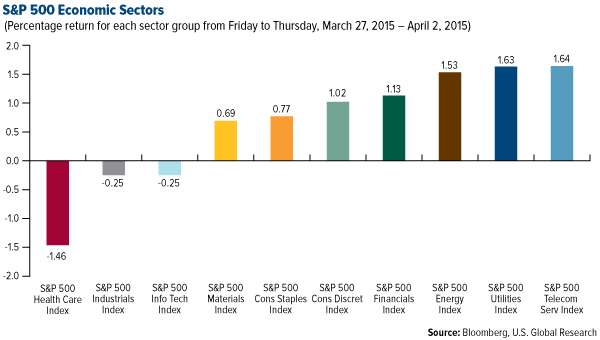
click to enlarge
Strengths
- The telecom services sector was the best performer this week led by Windstream Holdings which announced plans for a real estate investment trust (REIT) spin-off. This was viewed positively by investors as that portion of the company’s business would garner a higher valuation.
- The utility sector was also a strong performer as almost every utility stock in the S&P 500 rose this week as bond yields continue to fall and recent economic data points imply the Fed may stay on hold longer than currently expected.
- was the best performer in the S&P 500 rising 12.06 percent this week. On Thursday the company reported earnings and revenues for the fourth quarter that beat consensus expectations driving the shares higher.
Weaknesses
- The healthcare sector was the worst performing sector as biotech bellwethers got hit this week. Biogen and were among the worst performers in the S&P 500 this week. The biotech group has had a phenomenal run over the past few years but is beginning to look a little tired.
- The industrials sector was also weak this week as airlines stocks underperformed. While the positive secular story remains intact some analysts have made cautious comments regarding the near-term performance outlook.
- Macerich a real estate investment trust (REIT) was among the worst performers in the S&P 500 this week as the company rejected an unsolicited bid by Simon Property to acquire the company.
Opportunities
- While the market is closed tomorrow for the Good Friday holiday the government will release the March employment report. Nonfarm payrolls will be closely watched with current expectations for a gain of 245000. Job data has generally been positive in recent months and a better than expected report could boost the market when Monday rolls around.
- A strong dollar continues to benefit domestic consumers maintaining an advantage for certain U.S.-focused retailers and consumer products.
- The market ended the week on a positive note and the bull market just keeps moving forward.
Threats
- The consumer appears confident but recent data points indicate some unexpected conservatism that could weigh on growth prospects.
- Biotechs have been market darlings but may be showing their age; time will tell.
- The Fed still appears to be on track for a late summer rate hike.

The Economy and Bond Market
U.S. Treasury bond yields moved lower this week and have been declining for most of the past month. The Fed came across as more dovish than the market expected at the last Federal Open Market Committee (FOMC) meeting and data points since that time have tended to show an economy that is not as robust. The ISM manufacturing report this week is a good example declining for five months in a row. While still in expansion territory this report is definitely indicating a moderation in manufacturing activity.
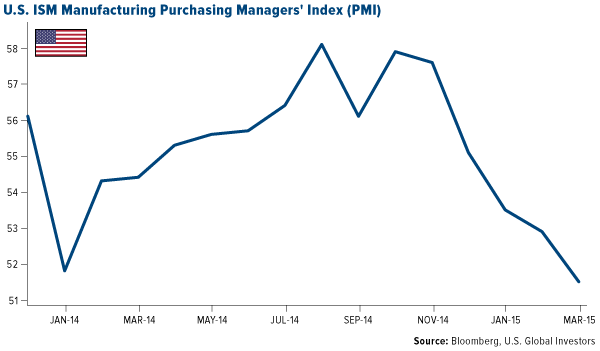
click to enlarge
Strengths
- Consumer confidence rose in March and is back near recent highs. An improved job market lower gasoline prices and stronger housing data have all been factors.
- Pending home sales rose 3.1 percent in February well ahead of expectations and another data point indicating an improving housing market.
- Chinese central bank officials indicated that there is room for additional monetary easing. China’s recent moves to ease monetary policy are a welcome addition to the global growth outlook.
Weaknesses
- The ISM manufacturing index fell again in March and has now declined for five months in a row. This is a bit of a worrisome development as it is indicating a moderation in manufacturing activity and may ultimately be one of the factors that keeps the Fed on hold in 2015.
- The U.S. savings rate hit a two-year high in February. In the long run this is likely a positive development; in the short term it is a drag on growth.
- Auto sales generally disappointed in March which is another indicator that the consumer may be less inclined to spend.
Opportunities
- European economic data is already on the mend and that should get an intermediate term boost as QE kicks in.
- China remains in monetary easing mode and more stimulus is likely.
- Even with the rally in yields this week U.S. yields remain the highest in the developed world and funds will likely continue to flow into U.S. fixed income.
Threats
- One of the themes from the recent earnings season was that the strong U.S. dollar has negatively impacted the bottom lines and capital spending plans of companies and this will likely be the case for the first quarter as well. This negative impact could be seen this week in weak manufacturing data.
- The Fed seems almost determined to raise interest rates irrespective of the near-term economic performance raising the risk of a policy error.
- With a global easing cycle underway global economic growth expectations have already started to improve making it an easier decision for the Fed to possibly raise rates.
 |
![[thumb]](http://www.usfunds.com/tasks/render/file/fileID=94CACFE5-083A-B14A-1408FAAE3ECF3C32&fileEXT=.jpg) March 31 2015 China to Take the Reins in Funding Regional Infrastructure Projects | ![[thumb]](http://www.usfunds.com/tasks/render/file/fileID=38F35F17-B1A4-02C5-FD5B558902393EC4&fileEXT=.jpg) March 30 2015 Innovation and Efficiency Drive U.S. Oil Supply and Demand | ![[thumb]](http://www.usfunds.com/tasks/render/file/fileID=670097A7-F601-D0A4-72C639D36767ADCE&fileEXT=.jpg) March 26 2015 A Tale of Two Economies: Singapore and Cuba |
 |
Gold Market
For the week spot gold closed at $1201.97 up $3.22 per ounce or 0.27 percent. Gold stocks as measured by the NYSE Arca Gold Miners Index rose 0.59 percent. The U.S. Trade-Weighted Dollar Index gained 0.23 percent for the week.
| Date | Event | Survey | Actual | Prior |
| Apr-2 | U.S. Initial Jobless Claims | 286K | 268K | 282K |
| Apr-3 | U.S. Change in Nonfarm Payrolls | 245K | - | 295K |
| Apr-9 | U.S. Initial Jobless Claims | - | - | 268K |
Strengths
- Gold jumped the most in two months on Wednesday topping $1200 an ounce. The move came on the back of a report showing U.S. employers added 189000 jobs in March disappointing expectations of 225000. This was the smallest gain in employment since January 2014 helping gold to end a three-session slump.
- Chinese gold flows as represented by withdrawals from the Shanghai Gold Exchange will hit record levels for the first quarter of the year. Year-to-date withdrawals stood at 561.2 tonnes as of March 20. If this is indicative of the rest of the year gold flows could reach 2300 tonnes or more in 2015 a new record.
- India’s gold imports jumped to 70 tonnes in March as wholesalers manufacturers and jewelers replenished stockpiles in the run up to April’s Akshaya Tritiya festival. In other news the Perth Mint said that sale of gold coins and minted bars rose to 34260 ounces in March up from 31981 ounces the previous month.
Weaknesses
-
- U.S. exchange-traded products backed by precious metals lost $1.5 billion in March. Janet Yellen’s signal that the is in no hurry to raise U.S. interest rates failed to allure investors back to gold. Additionally spot gold fell for a second month in March leading to a decline of slightly more than $1 for the first quarter.
- Hedge funds are betting that gold’s recent rally won’t last and are holding a record short wager that prices will decline. Short holdings rose for a seventh straight week to 84022 contracts the highest since the data began in 2006.
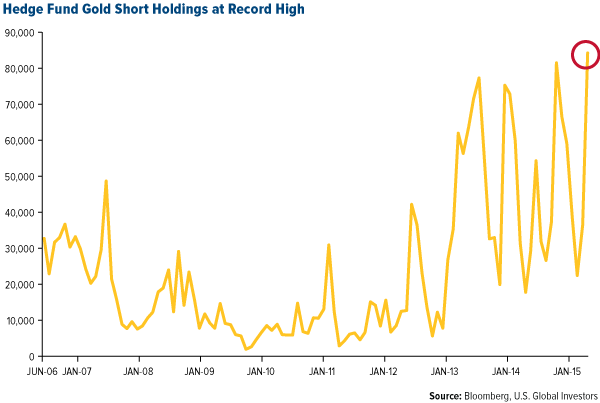
click to enlarge
- gave its top executives a pay raise of 21 percent in 2014. The news came on the heels of what are expected to be difficult wage negotiations in April with labor unions in South Africa.
Opportunities
-
- A recent forecast by shows that 2015 will be the year when gold production peaks. This coincides with a 20-year development cycle from peak discovery implying that there are only 20 years of known mineable gold reserves. Note how exploration spending has soared in the last five years but yielded few new discoveries. With exploration spending now in freefall this should bode very well for future acquisitions for companies that are have already made a great discovery. Such companies include Roxgold and others which we own in the World Precious Minerals Fund (UNWPX).
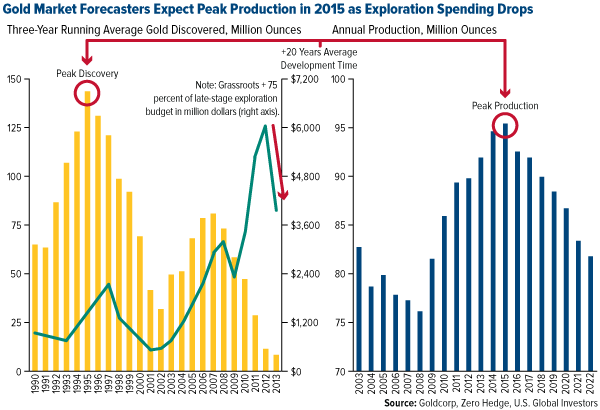
click to enlarge
- According to Standard Chartered and gold will likely advance in 2015 even as the raises interest rates snapping two straight years of declines. The two banks forecast the price of gold to average between $1300 and $1320 per ounce in the final quarter of the year.
- Metals Focus a precious metals consultancy predicted that 2015 could mark the end of the bear cycle for gold as demand looks “broadly balanced.” The group said a clearer turning point is becoming visible in 2016 as gold’s supply and demand fundamentals adjust to the new price reality and provide a more stable foundation.
Threats
- Metals Focus qualified its 2015 prediction on gold by stating that the outlook for higher U.S. interest rates and a stronger U.S. dollar could push bullion down to as low as $1080 per ounce.
- sees gold remaining relatively supported into the second quarter but is looking for a new phase of weakness to emerge as soon as the starts to tighten monetary policy. Countering this says there is no longer the same firepower behind a move lower for gold adding that any downside from here could well be contained.
- earned back its place as the largest bank by commodities revenue as competitors including JPMorgan Chase scaled down or abandoned the raw materials business. However Fed Governor Daniel Tarullo questioned whether should be allowed to own physical commodities as the practice exposes the company to risks outside of traditional banking.

Energy and Natural Resources Market
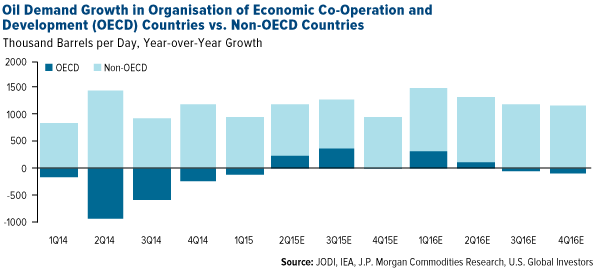
click to enlarge
Strengths
- Despite a slight decline in Brent crude oil this week the S&P 500 Oil & Gas Exploration & Production Index led all natural resource industries with a 2.5 percent gain. Diamondback Energy and Concho Resources both increased by 2.6 percent and 6.3 percent respectively.
- The Baltic Dry Freight Index breeched the 600 level for the first time since January. This is in contrast to the price of iron ore the freight benchmark’s primary commodity which fell to a fresh decade low.
- The S&P 500 Utilities Index gained 2 percent this week as competing government bond yields pulled back from recent highs.
Weaknesses
- The S&P Oil Refining & Marketing Index underperformed the natural resources complex in response to a narrowing of global refining differentials which had been gaining strength in the first quarter.
- The S&P Construction Materials Index declined 1.3 percent as investor money flows rotated into the energy complex on strengthening fundamentals.
- Railroad stocks continued to lag this week in response to disappointing quarterly earnings guidance and concern over freight rate acceleration in 2015.
Opportunities
- Crude oil supply could decline faster than expected given slower drilling and completion activity as of late. In the latest Energy Information Administration (EIA) Drilling Productivity Report expectations are pointing to a March to April decline in oil production in the Bakken and the Eagle Ford shale plays. Additionally the weekly Department of Energy production report showed a decline in production by 56 thousand barrels.
- obtained $3.5 billion in loans from China demonstrating its ability to raise capital much of which will be deployed in deep water drilling projects. Brazil's president Dilma Rousseff said this week that will take drastic measures to regain credibility and publish audited financial statements by the end of the month.
Threats
- The price of Brent crude oil may decline over the short term following an agreement with Iran over the country’s nuclear development program. Iran exports approximately 1 million barrels of crude oil per day down from 2.5 million before sanctions were imposed in 2012 according to the International Energy Agency (IEA).
- China's petroleum demand growth will slow down as China transitions toward a slower economy but crude oil imports will continue to grow said Chen Bo president of China International United Petroleum and Chemicals Co. Ltd. a member of Sinopec. China's annual growth of petroleum consumption demand is estimated to decline to 2 percent per year between 2015 and 2020 and 1 percent per year between 2020 and 2030 Chen said at a recent China-Russia Oil and Gas conference.


Legal Disclaimer:
MENAFN provides the information “as is” without warranty of any kind. We do not accept any responsibility or liability for the accuracy, content, images, videos, licenses, completeness, legality, or reliability of the information contained in this article. If you have any complaints or copyright issues related to this article, kindly contact the provider above.